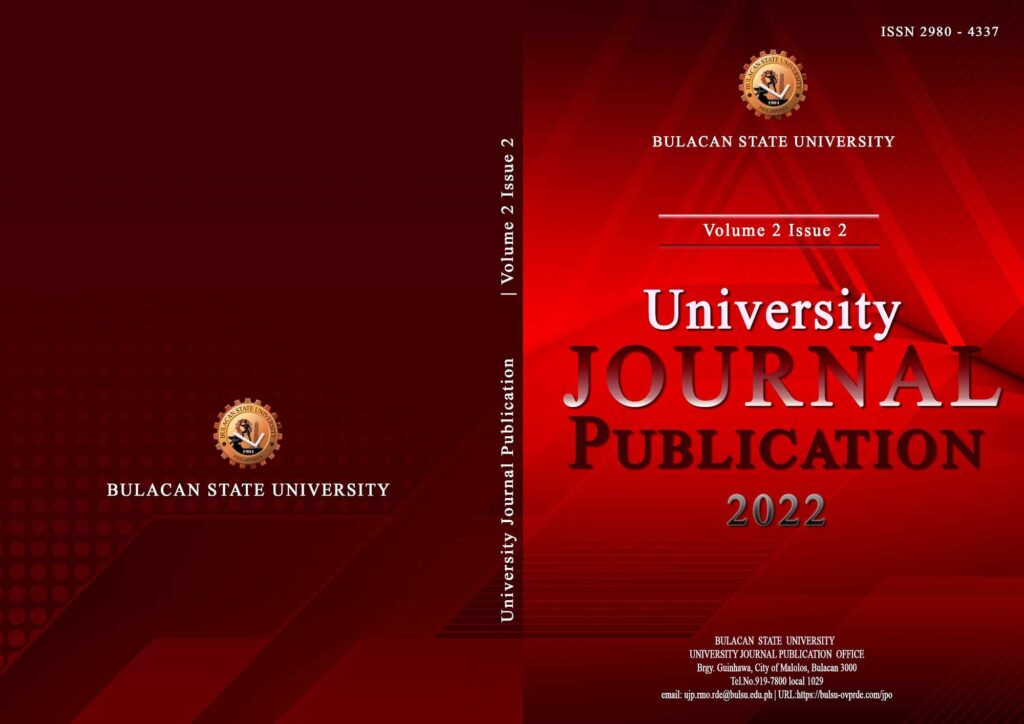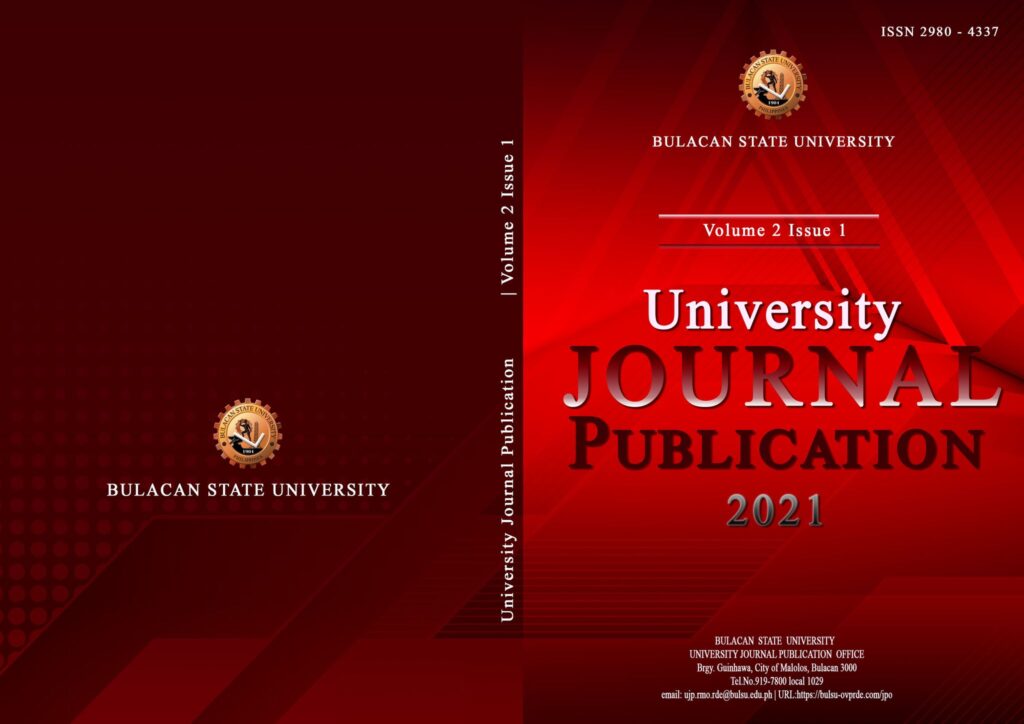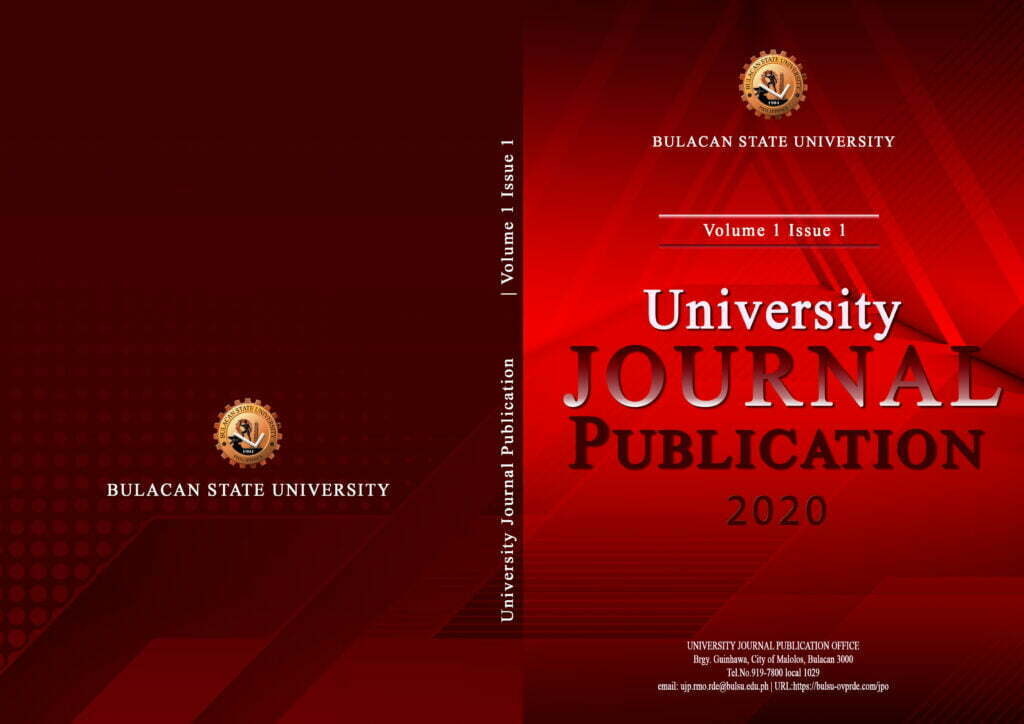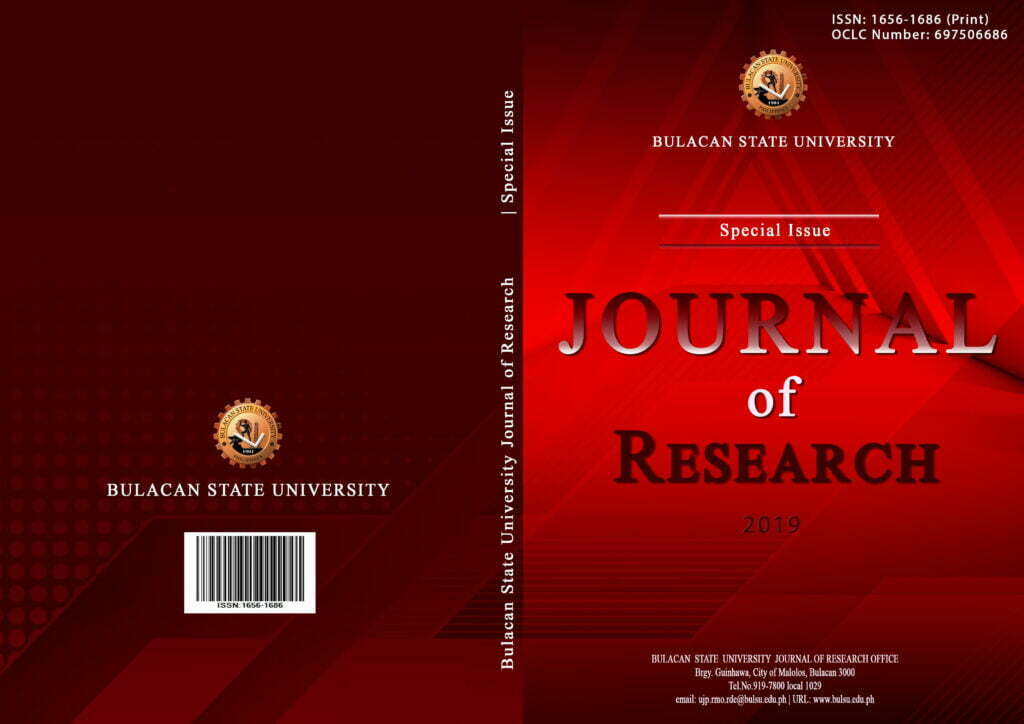BULSU UJPO
Journal Publication Office
Alpha Beta Gold E
ISSN 2980-4345 (Online)
Collaboration
Oxford Proofreading
URL: https://www.oxfordeditorials.com/collaboration.php
URL: https://www.oxfordeditorials.com/collaboration/calendar.php
Published by: Bulacan State University
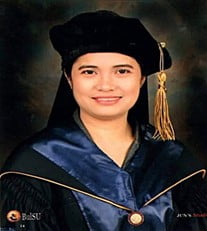
ANALIZA A. VILLACORTE, PH. D
Editor in Chief
Viewing from the spectacle of culture promotion in academic writing, by creating perfect symmetry between institutional research and international design that is making a high impact, University Journal Publication provides an academic publication platform for disseminating writing endeavors with the purpose of advancing intellectual capability and understanding of the key research components—Anib-Dampi, Balat, Yaman, Ugnay, and Kagyat—the breeding ground for new inventions and interventions.
Hence, the publication is the venue for disseminating research reports conducted at the university and promoting faculty development in research.
The Editor
The Bulacan State University Journal Publication
The University Journal Publication
is an open access academic journal published biannually by Bulacan State University (BulSU) that uses a double-blind peer-review evaluation in the Alpha Beta Gold E review method to promote the highest standard in research practice in the university. The publication prints and publishes electronically free access at https://bulsu-ovprei.com under the Research Management Office (RMO) BulSU UJPO (University Journal Publication Office) in its searchable database URL: https://bulsu-ovprei.com/jpo, and carrying identifier in the International Standard Serial Number (ISSN) portal. Print copies are archived in the repository of the ISSN National Center Philippines under the National Library of the Philippines, Bibliographic Services.
The double-blind peer-reviewed evaluation or refereed in the Alpha Beta Gold E review is the control mechanism that neutralizes the selection procedure and the publication. The Alpha review focuses on the soundness of the methodology and the impact of the interpretations on the quality of the journal; the Beta review focuses on the acceptability of the paper following the formatting style of the journal; and the Gold review is the final production of the manuscript for publication. E means collaboration with Europeans. This process integrates Oxford Proofreading to prepare the manuscript for publication following the international standard.
The following are the steps to BulSU UJPO publication:
Steps to BulSU UJPO Publication
Step One – Invitation to publish
The BulSU UJPO Editor-in-Chief sends invitations to publish to authors or lead authors, the name that appears first on the author list, together with the copyright form and the letter from the editor. The selection of manuscripts is RMO database dependent. RMO endorses the database of completed research- reported, pre-reviewed, evaluated, and monitored- for the specific fiscal year with reference to the target timeline for the regular publication. Special CALLs use different selection procedures and may open publication to other scholars and researchers.
Step Two – Signing of Copyright Agreement
The author/authors signify their intention to publish the manuscript by signing and sending the copyright agreement to o ujp.rmo.rde@bulsu.edu.ph.
Step Three – Acknowledgment of Intents to Publish the Manuscripts
The BulSU UJPO secretariat acknowledges the author’s copyright transfer and requests for the submission of the full paper. An email is sent as confirmation.
Step Four – Alpha Review
The revision of the manuscripts starts here. Once the full paper is received, the BulSU UJPO secretariat sends instructions on how to prepare the manuscript based on the approved UJP (University Journal Publication) Style and Format (Source: University Journal Publication Manual Article X&XI, pp 18-24). The Alpha review checks the soundness of the methodology and the impact of interpretation on the quality of the journal. The comments of the peer reviewers must be incorporated in the discussion. No changes in the process shall be made, only in the discussion.
Step Five – The Referee’s Report
After the Alpha revision or the first round, the manuscript will be returned to the peer reviewers for checking. The peer reviewers check if their suggestions have been incorporated in the revision which is highlighted using red font color. Highlighting the changes will make the checking faster. The invited peer reviewer recommends on the acceptability of the paper for publication after the Alpha revisions have been made.
Step Six – The Beta Review
Following the Alpha review is the Beta review. This part shares the notes of the Associate Editors (AE) to further improve the paper. The highlight of this part focuses on the formatting and the citation. A mentoring session may be facilitated should the authors wish to be guided with the revision and a virtual onboarding is accessible (See also Videos). The revised manuscript must be returned to ujp.rmo.rde@bulsu.edu.ph for checking.
Step Seven – Gold Review
The manuscript returns to the Associate Editor and the Production Editor for final review. The Production Editor sets the manuscript in LaTeX templates and prepares the initial version of the journal. Minor revisions are allowed during this process.
Step Eight –E Review or Oxford Proofreading
Oxford Proofreading edits and formats the manuscripts following the international standards.
Step Nine – Final Version
The final version of the manuscript will be sent to the author before publication. The author acknowledges the finality of the document. Revisions are not allowed in this process. The Editor-in-Chief decides on the acceptability of the final version of the manuscript for publication.
Step Ten – Printing and Publishing
The manuscripts are now ready for publication. The manuscripts are published in print and will be available for free access electronically. Each platform has its own ISSN.
Step Eleven – Incentivizing
Proofs of a publication grant the honorarium. Each published manuscript receives a ₱ 10,000.00 incentive and the peer reviewers receive a ₱ 2,000.00 honorarium.
Step Twelve – Promotion and Extension
BulSU UJPO exchanges printed copies of publications with libraries. It also provides databases, search engines, and visibility to other researchers, scholars, communities, and student researchers.
BulSU UJPO builds a network and opens CALLS for publication
Aim and Scope
The University Journal Publication of Bulacan State University traces the “directional movement of Philippine universities as a research and development laboratory as the mechanism in promoting the culture of integration and capacity building“ (UNESCO World Declaration on Higher Education). The aim is to give value to the research works conducted in the university by providing a publication platform for its faculty researchers to disseminate research reports for the use of the students, the community, and other researchers.
The publication advocates „cross country collaboration“ through borderless interaction and commitment to upholding dependency among other scholars around the world.
The publication is available for public domain, accessible worldwide with strict adherence to international practice in the conduct of research.
Guide to Authors
University journal publication is an open access non-commercial publication platform intended to disseminate the research reports of the faculty members conducted in the university. It is published bi-annually by Bulacan State University, a state-funded institution of higher learning. It envisions to promote cross-country collaboration, strengthen researches in the region, and commission researches that will encourage collaboration with other universities. The publication of manuscripts is database-dependent. The Research Management Office of the university endorses the database of completed researches for the target year of publication. The Editor-in-Chief sends personal invitation to publish to all authors in the specified target publication. Only the manuscripts that are peer-reviewed qualify for the publication.
Publishing Ethics
The University Journal Publication of Bulacan State University adheres to promoting international standards in the research practice. National and international professional conduct is required to protect the integrity of the journal. The University Research and Extension Council (REC) of the Bulacan State University reviews and recommends the research activities, while the RMO supervises them.
1. University Rule on Plagiarism
The University Journal Publication of Bulacan State University will strictly follow and accept a rule of text similarity, which is less than 10%, and will run using the existing plagiarism software. However, higher than 10% is considered a high percentage of plagiarism. Plagiarism is not acceptable in the University Journal Publication; hence, it will not be tolerated by the University. If discovered during the peer review process, the manuscript is automatically rejected. If plagiarism is detected after publication, the UJP can publish a correction or retract the publication.
This will amend, repeal, and modify all other rules on this particular matter.
2. University Rule on Original Research Manuscript
The University Journal Publication of Bulacan State University considers all original research manuscripts across a range of academic disciplines provided that it contains scientifically sound experiments and a substantial amount of new information. Data must be original and not inappropriately selected, manipulated, enhanced, or fabricated.
3. Authorship
The University Journal Publication of Bulacan State University strictly follows the relative contribution. The submitting author must ensure that all co-authors are included in the author list and that they have all read and approved the submitted version of the manuscript. All identified authors must have expressed their consent to be included as authors. The authors list must be declared upon signing the copyright. Corresponding Author(s)’s name and address are disclosed in the copyright transfer and are published in the journal.
The widely-adapted simple set of rules for determining authorship is the Vancouver Protocol*, which states that to be credited as an author, every author on a publication needs to have been involved in ALL of the following: A. Conception and design or analysis and interpretation of data ; B. Drafting the article or revising it critically for important intellectual content ; and C. Final approval of the version to be published.
4. Intellectual Property
The Philippines Intellectual Property Code on Copyright affirms an author’s moral rights related to an author’s copyright. Moral rights, distinct from economic rights, must be recognized and upheld. Researchers must comply with copyright law, and potential authors should likewise be cognizant of other authors’ moral rights. (Bulacan State University through its Innovation and Technology Support Office itso.rmo.rde@bulsu.edu.ph)
5. University Journal Management
The University Journal Publication Office of Bulacan State University, a government institution, is temporarily housed at the Research Management Office. Its processes are powered by the Google and Microsoft Office 365, and personalized LaTex typesetting software for editing, Grammarly for similarity checking, well-maintained Access database, and a searchable https://bulsu-ovprei.com/jpo/ website.
The Editorial Board is responsible for running and managing the publishing activities and fine-tuning the manuscript’s quality for publication. The editorial board consists of editor in chief, associate editor, managing editor, and production editor.
6. Peer Review Processes
The University Journal Publication Office of Bulacan State University uses a double-blind peer-reviewed evaluation in the Alpha Beta Gold review mechanism to promote the highest standard in research practice in the university, with future plans for cross-country collaboration and other publications.
The peer reviewers referee on the acceptability of the manuscript and the impact of the manuscript on the journal. The reviewers are given a personalized invitation as a peer reviewer being experts in the field, or have written a paper related to the unique disciplines in the different research management component- Anib-Dampi, Balat, Yaman, Kagyat, and Ugnay. A request for a referee is sent afterwards, should the expert accept the invitation with the orientation on how the evaluation should be carried out and the focus of review. Different sets of reviewers are selected to cater the “diverse aspects of peer review.”
The reviewers focus on the methodology and in the interpretation to eliminate research misconduct and to ensure proper care for the conduct of research and their subjects in the study. The publisher’s registered office is provided at the bottom part of this website should there be future concerns for correcting and allegation.
The Beta review revises the formatting and referencing following the latest APA Edition. This is the part where the Associate Editors incorporate their recommendations for the fine-tuning of the manuscript.
The Gold review of the process allows minimal corrections to allow the paper to qualify for publication. The manuscript will be re-evaluated on the measure of acceptability for publication. The editor-in-chief makes the final acceptance or rejection decision for a manuscript, usually after the author’s revision.
The E review is the integration of the Oxford Proofreading in preparing the manuscripts for publication following the international standards.
7. Data and Reproducibility
The journal is available in print and free access electronically. The proper attribution to the journal is requested to indicate reciprocity in the use of the knowledge retrieved from the journal. Please follow proper citation format to cite the Journal: University Journal Publication. https://bulsu-ovprei.com/jpo/
8. Ethical Oversight
A copyright agreement is signed as an indicator of consent to publication. The proper handling of the vulnerable populations and ethical conduct of research are regulated by the Ethics Committee during the conduct of research.
Journal 2022
Volume 2 Issue 2
Kitchen Chemistry: The Utility of Food and Biochemistry- Basic Laboratory Activities (FB-BLAc) for Instruction
Strides in Mathematics and Science: A Look into the First SHS Graduates’ Perceived Self-Efficacy
The Application of Ground Penetrating Radar in Analyzing Archaeological Cave Sites
The Outdoor Learning Spaces Design Framework: A Case Study for Integrating Outdoor Spaces for Learning in Bulacan State University
Perception of College Students on Teacher Bullying: Basis for Policy Inclusion in BulSU Student Handbook and BulSU Faculty Manual
Journal 2021
Volume 2 Issue 1
The development of Auto-generated code for Programming PIC16F877 Microcontroller
Micro-Controlled Recycling Machine that Converts Plastic Bottle Caps into Solid-State Oil Through Thermal Pyrolysis for Plastic Waste Reduction
Internet of Things-Based Remotely Simulated Educational Modular Robotics Trainer Utilizing ESP-NOW Protocol
Development of PET-Water Hyacinth Brick Maker
Automated Machine that Converts Charcoal Into Conductive Ink for Easier Circuit Prototyping with Monitoring Features
Assessment of Bulacan State University Employees Physical Activity amidst the Covid-19 Pandemic
Valuing Resilience Amid Covid-19
Challenges: Filipino College Students’
Experiences
Journal 2020
Volume 1 Issue 1
Performance Indicators of the Project “Mulat Sulat”: Impact of theThree-Year Duration of the CAL Extension Program in Bulakan
Expounding the Waray Language through Understanding Focus: A Guide in Teaching Waray Grammar
Improvement of Drivers’ License Issuance by Reducing Waiting Time using System Simulation
Commercial Production of Fish Squash Patties Utilizing Local Milkfish (Bangus)
Journal 2019
Special Issue
Stress Management Practices among Emergency Room Nurses in Bulacan Medical Center
Enhancing Barangay Justice System through the Development of Web-based Crime Monitoring Module
Cultivating Resiliency and Agility: A Vital Characteristics of Enactus-Bulacan State University
Videos
Editorial Board
Associate Editor: Jo Ann V. Reyes

